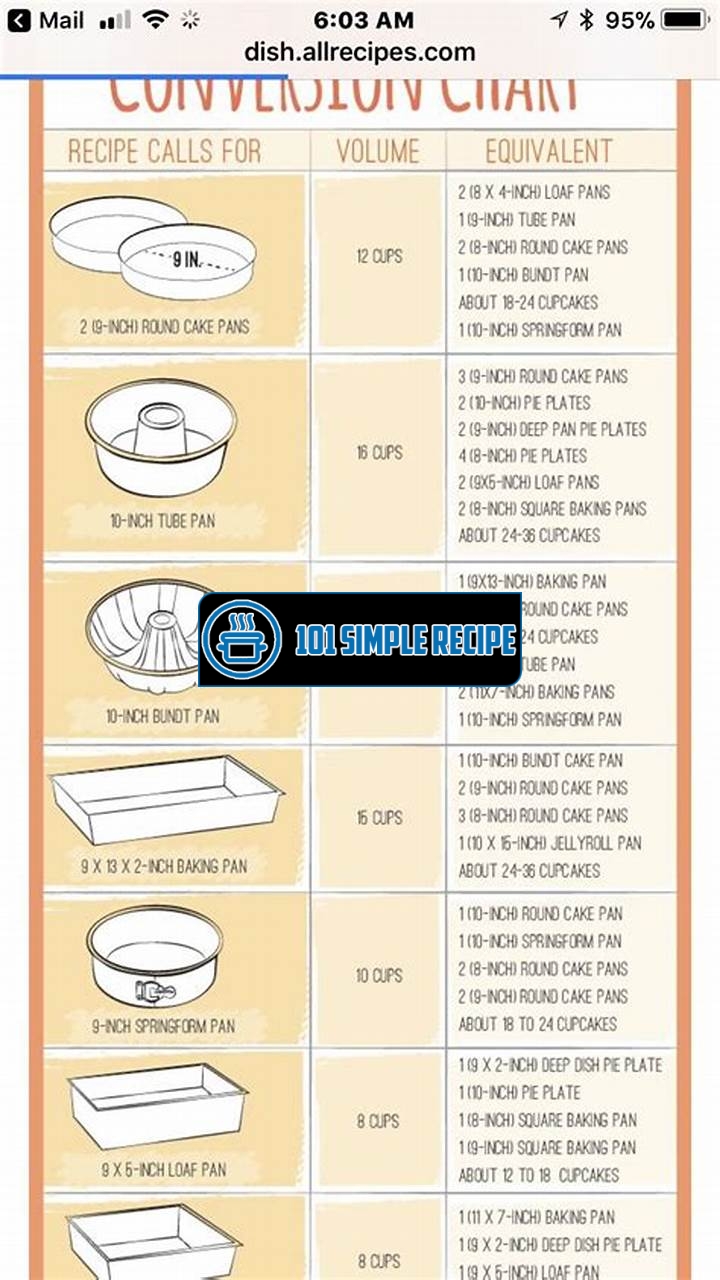Are you tired of constantly guessing which baking dish size is best for your recipes? Look no further! In this article, we will help you find the perfect baking dish size for effortless cooking. Whether you are a seasoned baker or just starting out, having the right dish size can make a world of difference in the outcome of your favorite dishes. Gone are the days of overflowing batters or dry and unevenly cooked meals. With our expert tips and guidelines, you’ll be able to select the ideal baking dish every time, ensuring your cooking experience is always a success. So let’s get started and take the guesswork out of choosing the right baking dish size!

Understanding Common Baking Dish Sizes
When it comes to baking, choosing the right dish size is crucial for achieving perfect results. The size of your baking dish can affect the cooking time, texture, and overall presentation of your baked goods. In this article, we will explore the various common baking dish sizes and how they can impact your baking endeavors.
Standard Baking Dish Sizes
Standard baking dishes come in a range of sizes, each suited for different types of recipes. The most common standard sizes include 9×13 inches, 8×8 inches, and 9×9 inches. The 9×13-inch baking dish is perfect for making larger family-sized meals, such as casseroles or lasagnas. It provides ample space for all the ingredients and ensures even cooking throughout. The 8×8-inch and 9×9-inch baking dishes are ideal for smaller recipes, like brownies or small quiches.
Note: It is important to consider the depth of the baking dish as well. A deeper dish can result in a longer baking time, as the heat needs to penetrate through a larger volume of ingredients.
For example, if you were to make a deep-dish pizza, you would need a baking dish with sufficient depth to accommodate the thick crust and toppings. On the other hand, if you were baking a shallow pie, like a fruit tart, you would want a baking dish with a shallower depth to ensure the crust bakes evenly.
Tip: When using a standard baking dish, it is essential to adjust the cooking time and temperature according to the recipe’s instructions. The depth and dimensions of the dish can significantly impact the baking process, so it’s crucial to follow the recipe closely for the best results.
Mini Baking Dish Sizes
Mini baking dishes are perfect for creating individual servings or for making small batches of your favorite baked goods. These cute and compact dishes are often used for personal-sized desserts, such as molten lava cakes or individual apple crisps. Common mini baking dish sizes include 4-inch, 5-inch, and 6-inch diameter dishes.
Pro Tip: Mini baking dishes are not only great for single servings but also for experiments and creativity. You can use them to make mini pies, mousses, or even portions of macaroni and cheese!
These smaller dishes allow for faster and more efficient baking, as the desserts or single portions cook through more quickly. They are also perfect for portion control, ensuring you don’t overindulge in your favorite treats.
Large Baking Dish Sizes
Large baking dishes are a baker’s best friend when preparing meals for a crowd or family gatherings. These generously sized dishes are commonly used for baking large roasts, holiday casseroles, or multi-layered cakes. The most common large baking dish sizes include 13×9 inches and 15×10 inches.
Fun Fact: When using a large baking dish, it is essential to consider the cooking time and temperature. Larger dishes may require a longer baking time or slightly adjusted oven temperature to ensure thorough cooking without burning the edges.
With a larger baking dish, you have the freedom to experiment and cook up delicious meals that can accommodate larger portion sizes. Whether you’re making a scrumptious lasagna or a mouthwatering chocolate cake, the larger dish size allows for uniform cooking and presentation.
In conclusion, understanding the common baking dish sizes is vital for achieving effortless cooking and perfect results. By selecting the right size for your recipe, you can ensure even cooking, proper portioning, and beautiful presentation. Whether you’re using a standard, mini, or large baking dish, taking note of the size and depth will help you become a master in the kitchen. Happy baking!
Selecting the Right Baking Dish Size
When it comes to baking, choosing the right dish size is essential for achieving perfect results. Whether you’re making a lasagna, casserole, or a classic apple pie, the size of your baking dish can greatly impact the outcome. Here is a guide to help you select the perfect baking dish size for your recipes and cooking needs.
Considerations for Recipe Yield
One important factor to consider when selecting a baking dish size is the recipe yield. If you are cooking for a large family or planning to have leftovers, you’ll need a dish with a larger capacity. On the other hand, if you are cooking for a smaller group or want to make individual servings, a smaller dish will do the job. Consider the number of servings you need to prepare and choose a dish size accordingly.
Keep in mind that some recipes may specify the required dish size, so be sure to follow those instructions for the best outcome.
Matching Dish Size to Cooking Temperature
Another crucial aspect of selecting the right baking dish size is matching it to the cooking temperature. Certain recipes, such as custards or delicate desserts, require gentle and even heat distribution. In this case, it’s best to choose a shallow and wide dish that allows for quick and efficient heat transfer.
On the other hand, dishes that need a longer cooking time, like casseroles or lasagnas, may benefit from a deeper dish that helps retain moisture and prevents the dish from drying out.
Adapting Recipes for Different Dish Sizes
It’s not uncommon to come across a delightful recipe that calls for a specific baking dish size that you don’t own. Don’t despair! Adapting recipes for different dish sizes is possible with a little creativity and some simple math.
The key is to maintain the original recipe’s proportions. For instance, if your recipe calls for an 8-inch square dish and you only have a 9-inch square dish, you can increase the recipe ingredients by 25% to match the larger dish size.
Conversely, if you need to use a smaller dish than what’s called for in the recipe, you can reduce the ingredients accordingly.
Keep in mind that adapting recipes for different dish sizes may affect the cooking time, so be sure to monitor your dish closely and adjust the cooking time as needed.
By considering these factors, you can confidently select the right baking dish size for your recipes and enjoy hassle-free cooking. Whether you’re baking a savory casserole or a sweet treat, the perfect dish size ensures even cooking and delicious results every time.
Common Baking Dish Materials
When it comes to choosing the right baking dish, the material plays a crucial role in determining the baking performance. Different materials have distinct properties that can affect the way your dishes turn out. Let’s take a closer look at the most common materials used in baking dishes: glass, metal, and ceramic.
Glass Baking Dishes
Glass baking dishes are a popular choice among home cooks for their versatility and even heat distribution. They are made from a tempered glass that can withstand high temperatures without breaking. The transparency of glass allows you to monitor the browning and cooking process. Glass dishes are also non-reactive, meaning they won’t interact with acidic ingredients, ensuring the flavors of your dishes remain intact. However, it’s important to note that glass takes longer to heat up compared to metal, so you may need to adjust your cooking times accordingly.
- Glass baking dishes provide even heat distribution for consistent baking results.
- They allow you to monitor the browning and cooking process through their transparent material.
- Glass is a non-reactive material that doesn’t affect the flavors of your dishes.
- Glass takes longer to heat up compared to metal, so adjust your cooking times accordingly.
Metal Baking Dishes
Metal baking dishes are known for their excellent heat conductivity, which allows for faster and more even baking. They are often made of aluminum or stainless steel, both of which are lightweight and durable. Metal dishes heat up quickly and cool down rapidly, making them ideal for recipes with short cooking times. However, metal can react with acidic ingredients, causing a metallic taste in your dishes. To prevent this, choose stainless steel baking dishes or opt for ones with a non-reactive coating.
- Metal baking dishes have excellent heat conductivity, resulting in faster and more even baking.
- They are lightweight and durable, making them easy to handle.
- Metal dishes quickly heat up and cool down, perfect for recipes with short cooking times.
- Avoid using metal baking dishes with acidic ingredients to prevent a metallic taste.
Ceramic Baking Dishes
Ceramic baking dishes offer great heat retention, allowing your dishes to stay warm for longer periods. They come in various designs and colors, making them a stylish addition to your kitchen. Ceramic is also a natural material that is non-reactive and doesn’t affect the taste of your food. However, compared to glass and metal, ceramic dishes tend to heat up slowly and unevenly. Preheating the dish before baking can help mitigate this issue.
- Ceramic baking dishes have excellent heat retention, keeping your food warm for longer.
- They come in various designs and colors, adding a stylish touch to your kitchen.
- Ceramic is a natural, non-reactive material that doesn’t alter the flavor of your dishes.
- Preheating the ceramic dish before baking helps to achieve more even heat distribution.
- 1 cup all-purpose flour
- 1/2 cup granulated sugar
- Preheat the oven to 350°F (175°C).
- Grease a 9×9 inch baking dish.
Note: It’s always important to follow the manufacturer’s instructions regarding temperature limits and other usage guidelines for each specific baking dish material.
By considering the different materials available for baking dishes and understanding their effects on baking performance, you can make an informed choice and find the perfect size and material for your effortless cooking experience.
Caring for Your Baking Dishes
When it comes to baking, having the right tools is essential. Your baking dishes are no exception. To ensure that your baking dishes last for a long time and provide you with effortless cooking experiences, it’s important to take proper care of them. Here are some essential tips for maintaining and prolonging the lifespan of your baking dishes.
Cleaning and Storing Baking Dishes
After each use, make sure to clean your baking dishes thoroughly. Gently scrub them with warm soapy water to remove any residue or grease. Avoid using harsh abrasives or metal scrubbers, as they can scratch the surface of your baking dishes. Rinse them well and dry them thoroughly before storing.
When it comes to storing your baking dishes, it’s best to stack them carefully. If you have multiple sizes, nest them inside one another to save space. Place a layer of parchment paper or a soft cloth between each dish to prevent them from scratching or chipping. Store them in a dry and cool place away from direct sunlight.
Avoiding Thermal Shock
Thermal shock can cause your baking dishes to crack or shatter. To avoid this, never place your baking dishes directly from the refrigerator to the oven or from the oven to a cold surface. Allow them to come to room temperature before subjecting them to extreme temperature changes. This will help prevent any sudden expansion or contraction that could damage your baking dishes.
If you need to reheat your food in the microwave, it’s best to transfer it to a microwave-safe dish instead of using your baking dish. Microwave ovens can heat unevenly and create hot spots that could potentially damage your baking dish. Be cautious and use the appropriate dishes for each heating method.
Handling and Transporting Baked Goods
When it comes to handling your baked goods, always use oven mitts or pot holders to protect your hands from the hot baking dishes. Avoid placing your baking dishes on delicate or heat-sensitive surfaces, as they can get damaged or stained. Instead, use trivets or heat-resistant mats to protect your countertops or table.
When transporting your baked goods, make sure to secure your baking dish properly. Support the bottom of the dish with one hand while holding the sides with the other. If you’re using a larger baking dish, consider using a sturdy baking pan carrier or a baking dish with a lid to prevent any accidental spills or mishaps.
Taking care of your baking dishes is an important part of being a successful baker. By following these essential tips, you can ensure that your baking dishes last for a long time and provide you with countless effortless cooking experiences. Remember to clean and store them properly, avoid thermal shock, and handle and transport your baked goods with care. With the right care, your baking dishes will continue to be your trusted companions in the kitchen.
Specialty Baking Dish Sizes
When it comes to baking, having the right dish size can make all the difference. While there are standard baking dish sizes that suit most recipes, there are also specialty baking dish sizes that cater to specific recipes and baking techniques. In this article, we will explore some unique baking dish sizes that will help you achieve the perfect results in your baked goods.
Individual Ramekins and Soufflé Dishes
Individual ramekins and soufflé dishes are perfect for creating single-serving desserts or soufflés. These small, round dishes typically have a capacity of 4 to 8 ounces. Whether you’re making individual chocolate lava cakes or classic cheese soufflés, these specialty baking dishes ensure that each serving is perfectly portioned and bakes evenly.
Using individual ramekins and soufflé dishes also allows for beautiful presentations. You can serve your desserts directly in these dishes, adding an elegant touch to your table setting. They are also versatile and can be used for savory dishes like individual pot pies or gratins. The possibilities are endless when it comes to these charming baking dish sizes.
Springform Pans
Springform pans are a favorite among bakers for their versatility and ease of use. These round baking pans have removable sides that can be unlatched, allowing you to effortlessly release delicate cakes without damaging them. Commonly used for cheesecakes, springform pans come in various sizes, ranging from 8 to 12 inches in diameter.
The adjustable sides of the springform pans make them ideal for creating tall and layered cakes, as well as other desserts like tarts and quiches. The tight seal of the pan prevents leaks and ensures even baking throughout. With a springform pan, you can easily impress your guests with perfectly shaped and delectable treats.
Bundt Pans and Tube Pans
Bundt pans and tube pans are distinctive baking dishes that add an impressive design to your cakes. These pans have a distinctive ring shape and a center tube that allows for even heat distribution. Bundt pans vary in size, with capacities ranging from 10 to 15 cups.
Using a bundt or tube pan gives your cakes a stunning appearance without the need for elaborate decorations. The center tube also aids in baking the cake evenly, resulting in a moist and evenly cooked dessert. Whether you’re baking a classic pound cake or a decadent chocolate bundt cake, these specialty baking dish sizes will surely elevate your culinary creations.
In conclusion, exploring specialty baking dish sizes opens up a world of possibilities in the realm of baking. Individual ramekins and soufflé dishes are perfect for single-serving desserts, while springform pans offer versatility for various cakes and tarts. Bundt pans and tube pans add an extraordinary design to your cakes. Invest in these specialty baking dish sizes, and you’ll be well on your way to effortless baking success!
Frequently Asked Questions
Here are some frequently asked questions about common baking dish sizes:
| No. | Questions | Answers |
|---|---|---|
| 1. | What are the common baking dish sizes? | The common baking dish sizes range from small to large. Small baking dishes typically measure around 8×8 inches, while medium ones are usually 9×13 inches. Large baking dishes can vary, but a common size is 10×15 inches. It’s important to check the specific measurements before purchasing a baking dish for a recipe. |
| 2. | Are there any standard sizes for baking dishes? | While there are common sizes for baking dishes, it’s important to note that there is no official standard. The sizes mentioned earlier are widely used and can be found in most kitchenware stores. However, some recipes may require different sizes or shapes of baking dishes, so always refer to the specific instructions in the recipe. |
| 3. | Can I use a different size baking dish than the one specified in a recipe? | In general, you can use a different size baking dish than the one specified in a recipe, but it may affect the cooking time and result in a different outcome. If you are using a larger dish, the batter or dough may spread out more thinly and cook faster. If you are using a smaller dish, the batter or dough may be thicker and require a longer cooking time. It’s best to adjust the cooking time and keep an eye on the dish while it bakes to ensure it is cooked through properly. |
| 4. | Can I use glass or ceramic baking dishes instead of metal ones? | Yes, you can use glass or ceramic baking dishes instead of metal ones. Glass and ceramic dishes are good alternatives as they distribute heat more evenly and can help prevent overbrowning. However, keep in mind that glass and ceramic dishes may require slight adjustments to the cooking time and temperature, as they retain heat differently compared to metal dishes. |
| 5. | What should I do if a recipe calls for a baking dish size that I don’t have? | If a recipe calls for a specific baking dish size that you don’t have, you can try using a different dish size that is close in capacity. For example, if a recipe calls for a 9×13 inch baking dish but you only have an 8×8 inch dish, you could divide the batter or dough between two 8×8 inch dishes to achieve a similar result. Just make sure to adjust the cooking time accordingly and keep an eye on the dish while it bakes. |
| 6. | Where can I find baking dish size conversion charts? | Baking dish size conversion charts can be found online or in cookbooks that specialize in baking. These charts provide conversions for different dish sizes and help you determine the appropriate adjustments to make for your recipes. It’s a helpful resource to have on hand when you need to adapt a recipe to the baking dish sizes you have available. |
Thanks for Reading!
We hope this article provided useful information about common baking dish sizes. Next time you’re in the kitchen, remember to choose the right baking dish for your recipe to achieve the best results. If you have any more questions, feel free to visit our website again for more cooking tips and articles. Happy baking!
Jump to Recipe
Common Baking Dish Sizes

Learn about the common baking dish sizes and how to choose the right one for your recipes.






